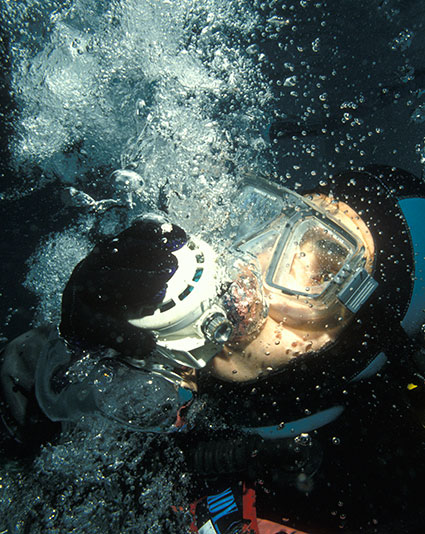Diving in Freezing Water? U.S. Navy Tests Flunk Some RegulatorsContents of this Issue: Okeanos Aggressor II, Cocos Island, Costa Rica Older, Deeper, Longer and a Guinness Record Lady Elliot Island, Queensland, Australia Pulmonary Edema and Those Little Blue Pills The Great Barrier Reef; Dive it Now Are Hurricanes Damaging Your Dive Plans? A Close Encounter in the Baltic? Diving in Freezing Water? U.S. Navy Tests Flunk Some Regulators Were These Divers Electrocuted? Ear Infections and the ProEar Solution Is It Time To Hang Up Our Fins? Bahamas Conch Populations in Jeopardy Stuart Cove Guide Fired for Pummeling a Shark Are Some Snorkels and Snorkel Masks Death Traps? Editorial Office: Ben Davison Publisher and Editor Undercurrent 3020 Bridgeway, Suite 102 Sausalito, CA 94965 from the October, 2017 issue of Undercurrent
It's unlikely that many Undercurrent readers regularly dive in cold water unless they are visiting a freshwater lake or deep wreck diving, but someday you might take a trip to Iceland's Silfra or join one of Amos Nachoum's trips to the Antarctic or Norway. That said, since the depressurization of gas in a regulator results in a simultaneous drop in temperature, any water 50°F (10°C) or less can cause a regulator to freeze and malfunction. The first-stage may jam, resulting in increased inter-stage pressure that the second-stage cannot control, causing a free-flow, or, in a worse case, even occluding air-flow because of an ice build-up in the second-stage. Researchers from The U.S. Navy Experimental Diving Unit and the University of California, San Diego, tested the performance of regulators for under-ice diving operations, during which 17 science divers logged 305 dives in seawater close to freezing under 20-foot (6m) - thick ice in Antarctica. Seventeen different regulators from 12 manufacturers (69 in total) were randomly assigned to divers. There were 65 incidents of free-flows. Due to the risk of regulator failure, the divers were equipped with two independent regulators on a tank Y-valve with drysuit direct-feeds supplied from the backup regulator. All the downstream regulators were equipped with an isolator valve inline on the intermediate pressure hose. Recently, the U.S. Navy has recommended the Zeagle isolator valve for freezing water temperatures, in conjunction with a high-pressure relief valve. Besides water temperature affecting whether a regulator freezes, airflow, moisture in exhaled breath, and whether or not it was breathed from in cold atmosphere before immersion, can also affect freezing. "Contrary to expectations, the pooled incidences for the seven best performing regulators was significantly different from the 10 remaining regulators. Those regulators deemed acceptable -- their failure rate was less than 11 percent -- were the Dive-Rite Jetstream, Sherwood Maximus SRB3600 and SRB7600, Poseidon Jetstream, Cyklon and Xstream Deep, and Mares USN22 Abyss." The report did not list those that were unacceptable. The report concludes that those diving under ice must constantly be on their guard. "Because of the pressures of the marketplace, scuba regulator models typically have a short half-life. However, designing a regulator tolerant to freeze-up is a black art for most manufacturers, and even 'minor' cosmetic changes can affect 'freeze-up' risk." (Performance of life support breathing apparatus for under-ice diving operations. UHM 2017 Vol 44, No.4 Michael A Lang PhD, John R. Clarke PhD) |

I want to get all the stories! Tell me how I can become an Undercurrent Online Member and get online access to all the articles of Undercurrent as well as thousands of first hand reports on dive operations world-wide
| Home | Online Members Area | My Account |
Login
|
Join
|
| Travel Index |
Dive Resort & Liveaboard Reviews
|
Featured Reports
|
Recent
Issues
|
Back Issues
|
|
Dive Gear
Index
|
Health/Safety Index
|
Environment & Misc.
Index
|
Seasonal Planner
|
Blogs
|
Free Articles
|
Book Picks
|
News
|
|
Special Offers
|
RSS
|
FAQ
|
About Us
|
Contact Us
|
Links
|
3020 Bridgeway, Ste 102, Sausalito, Ca 94965
All rights reserved.


